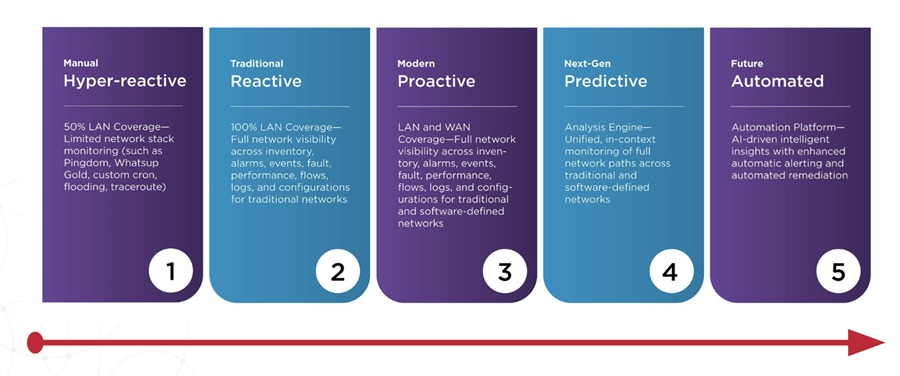Why do outages of mission-critical applications still happen? Aren't there multiple solutions that can alert IT teams to problems? Yes – and that can be part of the problem. One alarm goes off, and then another and another until the team is quickly overwhelmed. By the time an incident like this is brought under control, the company may have lost on average as much as $750,000 for a 90-minute outage, according to the Ponemon report, Cost of Data Center Outages, in addition to loss of face and damage to brand value.
What typically happens next is that forensic experts go through multiple product consoles and logs to identify the cause of an incident, and the blame gets passed around as time ticks away. But deep machine learning-based, root-cause analytics and predictive analytics technologies are helping organizations dramatically prevent such incidents and reduce mean time to repair.
In a digital-first world, teams must manage unparalleled amounts of data while predicting and preventing outages, in real time, while maintaining and delivering agile, reliable applications. The problem is that most organizations must tap several different siloed vendor tools to assist in the monitoring, identifying, mitigation and remediation of incidents and hope that they speak to each other, which traditionally hasn't happened.
IT infrastructure keeps changing from physical to hybrid and multi-cloud environments, and new architectures keep arising. Consequently, it is becoming impossible for IT administrators to keep up with the multitude of objects, with thousands of metrics generating data in near-real time.
Applications in today's environments need to be reliable and secure within these high performance environments, so new approaches must be employed to provide intelligence. Automated, self-learning solutions that analyze and provide insight into applications and infrastructure topologies are essential in this transformation.
The New Language of Monitoring Tools
Vendors are throwing around phrases like "big data" and "machine learning" because organizations understand that these features can help them tackle the complex needs of application performance. But what do they really mean?
Machine Learning: Machine learning is self-learning, supervised or unsupervised algorithms that can be based on neural networks, statistics or Digital Signal Processing et al.
Big Data Architecture: A framework for managing masses of structured and unstructured data in an automated, highly scalable way using open source technologies.
Domain Knowledge: Questions about what happened, what caused it, how to remediate it and prevent it from happening again – the domain knowledge in TechOps and DevOps helps answer them.
5 Questions About Your Monitoring Solution
Ask these 5 questions before moving forward with a monitoring solution that can address application outages:
1. Immediate Intelligence: Does the solution identify in real time, those alarms that need immediate attention?
2. Scalability: Does the solution scale and is it able to handle millions of objects?
3. Automation: Does it quickly pinpoint the root cause of the problem and identify how to fix it, rather than relying on expensive domain experts?
4. Communal Wisdom: Do you have access to tribal knowledge such as vendor knowledge bases, discussion forums and the latest state-of-the-art technologies in order to help teams remediate incidents quickly and efficiently?
5. Prevention: Historically, monitoring tools send alerts only after a problem has already occurred or when the rules and set thresholds are violated, but the key to preventing outages is to predict issues in advance. Does the solution provide alerts to anomalous trends or potentially dangerous issues before they impact your application?
Yesterday's siloed IT management tools tend not to communicate with each other, causing confusion and over-alerting. This makes it difficult, if not impossible, for IT teams to determine what's worth investigating and what's not – paving the way for service disruptions and breaches. Fortunately, today's solutions offer real-time insight and recommendations for remediation, as well as analytics that can predict trouble so you can stop problems before they start.


